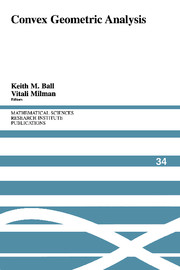Book contents
- Frontmatter
- Contents
- Introduction: The Convex Geometry and Geometric Analysis Program MSRI, Spring 1996
- Msri Program Seminars
- Integrals of Smooth and Analytic Functions over Minkowski's Sums of Convex Sets
- Localization Technique on the Sphere and the Gromov-Milman Theorem on the Concentration Phenomenon on Uniformly Convex Sphere
- Geometric Inequalities in Option Pricing
- Random Points in Isotropic Convex Sets
- Threshold Intervals under Group Symmetries
- On a Generalization of the Busemann-Petty Problem
- Isotropic Constants of Schatten Class Spaces
- On the Stability of the Volume Radius
- Polytope Approximations of the Unit Ball of ℓnp
- A Remark about the Scalar-Plus-Compact Problem
- Another Low-Technology Estimate in Convex Geometry
- On the Equivalence Between Geometric and Arithmetic Means for Log-Concave Measures
- On the Constant in the Reverse Brunn-Minkowski Inequality for p-Convex Balls
- The Extension of the Finite-Dimensional Version of Krivine's Theorem to Quasi-Normed Spaces
- A Note on Gowers' Dichotomy Theorem
- An "Isomorphic" Version of Dvoretzky's Theorem, II
- Asymptotic Versions of Operators and Operator Ideals
- Metric Entropy of the Grassmann Manifold
- Curvature of Nonlocal Markov Generators
- An Extremal Property of the Regular Simplex
- Floating Body, Illumination Body, and Polytopal Approximation
- A Note on the M*-Limiting Convolution Body
Introduction: The Convex Geometry and Geometric Analysis Program MSRI, Spring 1996
Published online by Cambridge University Press: 27 June 2025
- Frontmatter
- Contents
- Introduction: The Convex Geometry and Geometric Analysis Program MSRI, Spring 1996
- Msri Program Seminars
- Integrals of Smooth and Analytic Functions over Minkowski's Sums of Convex Sets
- Localization Technique on the Sphere and the Gromov-Milman Theorem on the Concentration Phenomenon on Uniformly Convex Sphere
- Geometric Inequalities in Option Pricing
- Random Points in Isotropic Convex Sets
- Threshold Intervals under Group Symmetries
- On a Generalization of the Busemann-Petty Problem
- Isotropic Constants of Schatten Class Spaces
- On the Stability of the Volume Radius
- Polytope Approximations of the Unit Ball of ℓnp
- A Remark about the Scalar-Plus-Compact Problem
- Another Low-Technology Estimate in Convex Geometry
- On the Equivalence Between Geometric and Arithmetic Means for Log-Concave Measures
- On the Constant in the Reverse Brunn-Minkowski Inequality for p-Convex Balls
- The Extension of the Finite-Dimensional Version of Krivine's Theorem to Quasi-Normed Spaces
- A Note on Gowers' Dichotomy Theorem
- An "Isomorphic" Version of Dvoretzky's Theorem, II
- Asymptotic Versions of Operators and Operator Ideals
- Metric Entropy of the Grassmann Manifold
- Curvature of Nonlocal Markov Generators
- An Extremal Property of the Regular Simplex
- Floating Body, Illumination Body, and Polytopal Approximation
- A Note on the M*-Limiting Convolution Body
Summary
During the last ten years the integral geometry of convex bodies has undergone a dramatic revitalisation, brought about by the introduction of methods, results and, most importantly, new viewpoints, from probability theory, harmonic analysis and the geometry of finite-dimensional normed spaces. The principal goal of this program was to bring together researchers from several different fields, Classical Convex Geometry, Geometric Functional Analysis, Computational Geometry and related areas of Harmonic Analysis. The main reason for doing so was that research in these areas has found considerable overlap in recent years. Several problems and classes of problems have been come upon independently from different directions, and techniques from some areas have been found important in others. This goal was achieved beyond even our most optimistic expectations.
As well as an introductory workshop, consisting of four lecture series with an educational format, the program included one full-scale research workshop and two concentrations of visitors, in addition to the regular activity during the principal five months. About 190 mathematicians attended the program in some capacity or other and there were over 150 lectures and seminars during the period. These were of several types. There was a regular educational seminar, two or three times a week which enabled participants to become acquainted with material from other fields. Three or four lectures a week dealt with recent research by members, and there was a “young research seminar” (roughly once a week) which gave postdocs and students a chance to describe their work in an informal atmosphere.
Information
- Type
- Chapter
- Information
- Convex Geometric Analysis , pp. ix - xPublisher: Cambridge University PressPrint publication year: 1999
